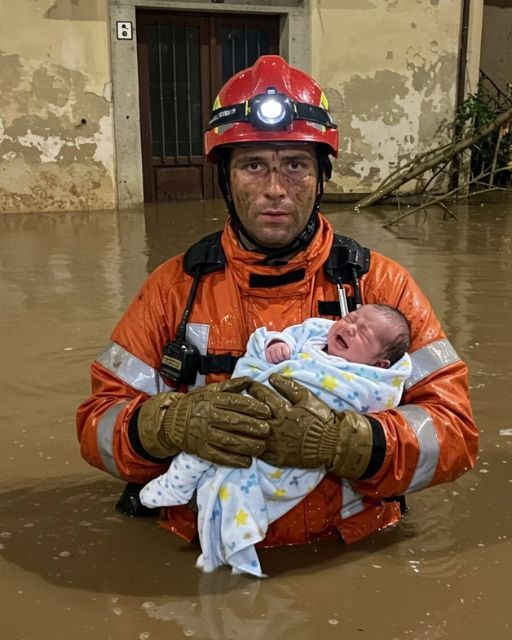He’s been with Search & Rescue for as long as I can remember. Years of training, years of risking his life, years of pushing his body into places most people wouldn’t even dare to look at. I’ve watched him walk into chaos like it was nothing. I’ve seen him carry full-grown men out of mudslides when the ground itself was breaking apart under his feet. I’ve seen him climb into roofs that were seconds from collapsing, pulling out survivors with nothing more than sheer strength and stubborn will. I’ve even seen him dive into pitch-black floodwaters without backup, when the sonar glitched and everyone else hesitated, because he couldn’t live with the thought that maybe—just maybe—someone was still down there waiting. He was fearless, relentless, almost unshakable. That’s why the photo unsettled me so deeply—because in all those years, I had never seen him look like this. His eyes, even through the blur of a satellite phone image, told me something was wrong.
He sent the photo with only a short message: “We pulled the baby from Building 6.” At first, I didn’t question it—he’s sent dozens of these updates over the years. But then the words began to settle in my mind, and unease spread like a slow poison. Because I knew Building 6. Everyone in the family did. It wasn’t residential. It wasn’t a place where a baby should have been. Building 6 had once been a small, cozy bakery, the kind that filled the street with the smell of bread in the mornings. But years ago, it was sold, gutted, and converted into a short-term office rental. Cubicles, desks, flickering fluorescent lights—cold, impersonal space. No cribs. No families. No reason for an infant to ever be there. And the front door? Reinforced steel, padlocked, rust creeping around the hinges. According to the records, it hadn’t been opened in years. That’s what made the photo so impossible.
I couldn’t shake it, so I zoomed in on the picture, staring until my vision blurred. The child was wrapped in a fleece blanket, soft and delicate, patterned with stars and clouds. My stomach dropped. It wasn’t just any blanket—it was the blanket. The one our aunt had spent weeks stitching by hand, sewing each star with patience, weaving every cloud with care. She made it six months ago, as a gift for her daughter’s baby boy. But the baby never came home. He was stillborn. And when they buried him, my aunt insisted on laying that blanket with him in the tiny white casket, saying it was the only way she could still give him warmth. We all stood there that day, silent, watching her hands linger on the fabric before the lid was closed. There was no mistaking it. The baby in the photo was wrapped in the same blanket that should have been resting in the earth.
I didn’t want to say anything. The thought itself felt cruel, twisted—like my mind was playing tricks on me in the middle of grief and disaster. But the longer I stared, the harder it was to breathe. My chest tightened. A part of me wanted to believe it was a coincidence, some mass-produced fabric bought by dozens of families. Yet deep down, I knew it wasn’t. It couldn’t be. The stitches weren’t generic. They were hers. Every cloud slightly uneven, every star a little different in size. This wasn’t mass-market—it was handmade. Unique. Impossible to confuse with anything else.
Before I could bring myself to confront him about it, my phone rang. It was my cousin. Her voice was unsteady, trembling in a way I’d only heard once before—the night of the funeral. She didn’t ask how I was or if I’d seen the news. She only said one thing: “You need to come over. Now. It’s about the baby.”
